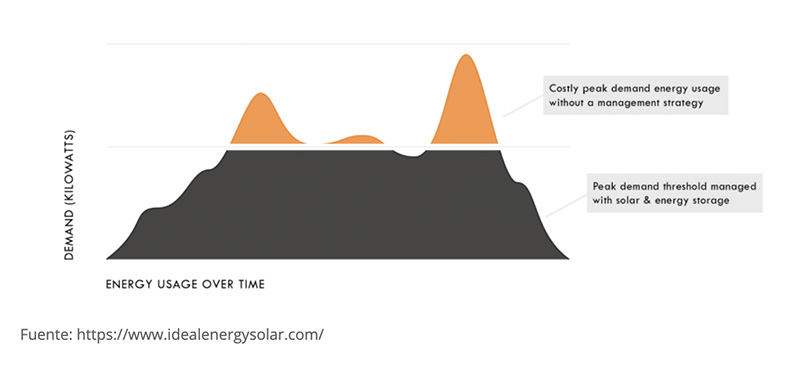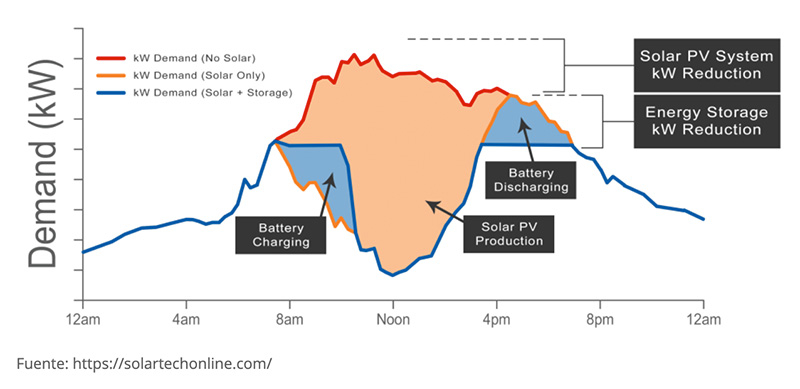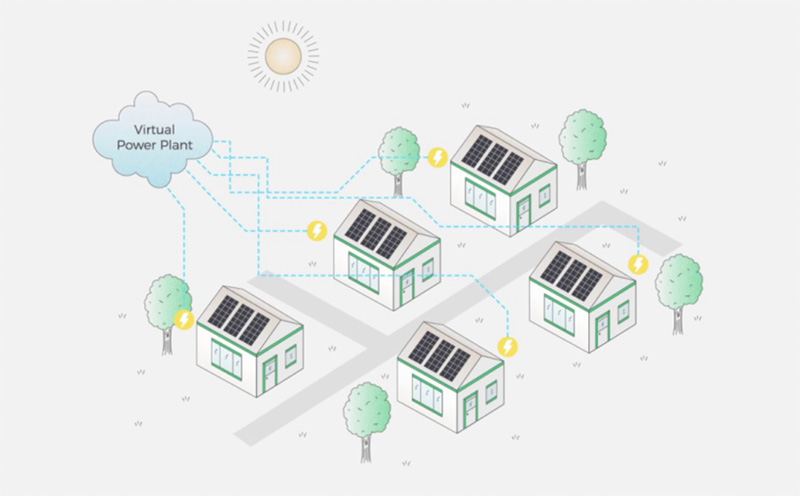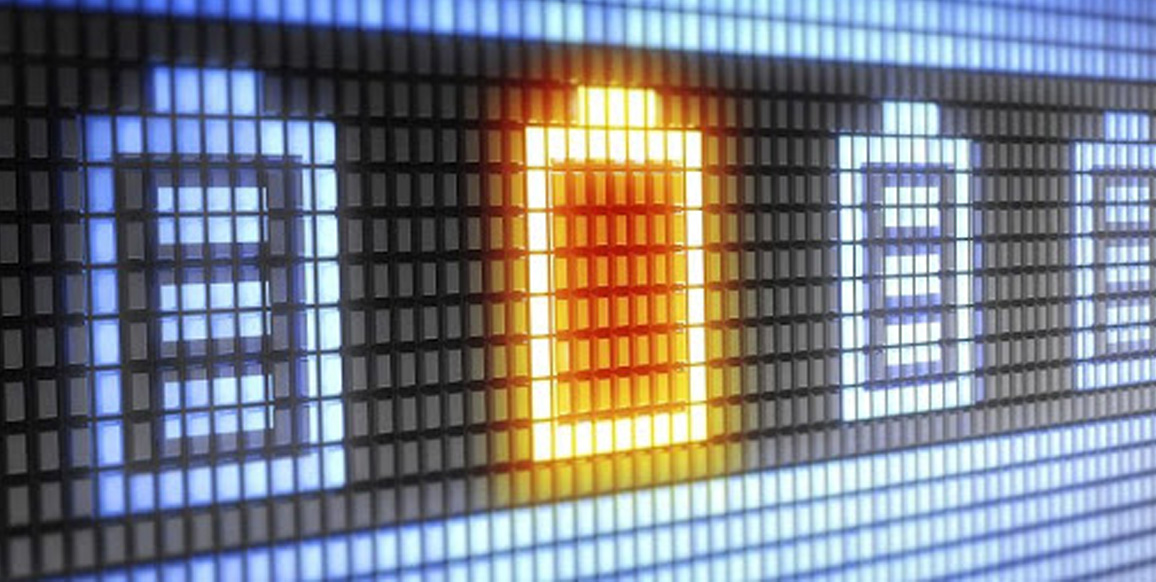In today’s world of disruptive technology, renewable energy is no stranger to the limelight. Increased solar cell efficiency and greater battery storage capacity are just a few of the trends driving the industry. At Avolta Energy, we stay up to date on these advancements to ensure our customers are getting the best performance from their solar system. An investment in stand-alone solar is money well spent: solar energy is a great way to lower utility expenditures. However, where we are seeing new levels of savings is in medium-to-large photovoltaic (PV) systems with battery storage, or solar storage systems.
All about savings
‘Peak shaving’ helps reduce demand charges on monthly utility bills.
A commercial electricity utility bill usually has two types of charges: a consumption charge and a demand charge. A consumption charge is a charge for the amount of energy you consume over a billing period, measured in kilowatt-hours (kWh). The rate you pay for this charge ($/kWh) is determined by your utility provider.

Demand charges are based on the greatest amount of power a customer uses during a billing cycle, measured in kilowatts (kW). For many commercial customers drawing from the grid, demand charges can account for 30% – 70% of a monthly electricity bill. During instances of high demand a customer with solar storage is able to ‘peak shave’ and manage their demand threshold by discharging their battery. The savings from reducing demand charges can help cover the initial investment of a battery.

‘Load shifting’ allows business to purchase power when it is cheaper, reducing overall energy costs.
A load profile is a term used to describe the load, or electrical demand, of a user over time. ‘Load shifting’ is a method of cost-saving wherein a business changes their load profile, effectively shifting the time they draw power from the grid. In the graphic below we can see the demands of 3 distinct energy systems: no solar, stand-alone solar and solar with battery storage. In the stand-alone and solar storage systems, demand is low mid-day because the panels directly power the user’s load. For the stand-alone solar system, power must be purchased later in the day to meet demand. Here, solar has significantly reduced power draw from the grid but can’t meet the full demand at peak hours of the day.

In these instances, solar storage systems are more effective at meeting instantaneous demand and allow for a significant reduction in the peak demand threshold. Using intelligent software the battery knows to charge up when electricity is cheap. Then, later in the day the battery discharges and is able to utilize that cheap power when price and demand are high.
Batteries and your business
In the event of a blackout, a battery provides stability to your businesses’ infrastructure.
A battery can help prevent your business from experiencing a full loss of power, particularly important in areas prone to outages. Generally speaking, a battery will not be able to keep the entire load of a business running for very long. However, batteries can be configured to power specific loads when a blackout does occur. Be it refrigeration, Wi-Fi, lights, or AC, as system owner you have the ability to make that decision. The vital services of your choosing can continue operation and help avoid the spoil of product, declined productivity or disconnect from the Internet.
Battery storage makes your businesses more resilient to the intermittency of solar.
The Achilles heel, so to speak, of renewable energy sources such as wind and solar is their intermittency. One of the realities of using solar to power your business is that the sun may not always be shining. When your solar system is not producing energy at capacity, battery storage enables you to get the cheapest energy available.
It’s green energy folks!
Solar and battery systems are a sustainable energy source and by utilizing them you are doing your part in lowering carbon emissions. Our smart energy solutions will not only save you money, but also help your business reach sustainability goals and foster a ‘green’ public image. Come checkout our battery storage products and services to help get your business on the fast-track to savings!
Don’t forget grid-services!
Battery storage systems allow businesses to be part of Virtual Power Plants (VPP).
Any source that can generate or provide on-demand power can be part of a VPP, including a solar storage system. Taking advantage of the existent IT infrastructure, VPPs digitally pool together various power sources to meet peaks in electricity demand. By implementation, VPPs replace reliance on carbon-emitting peaker plants, while serving as a source of income to businesses with excess energy.

Using AI, smart inverters can utilize solar storage systems as a power source to maintain grid stability.
Voltage and frequency across the grid can sometimes deviate, though ideally these variables are synchronized to optimize power on the grid. Inverters can change their power output (either automatically or upon request) to restore the standard frequency of the grid. Additionally, changing power output can help control the supply and demand of the grid, a service known as automation generation control.
Solar and battery systems can supply reactive power, improving the efficiency of the grid.
Reactive power can be used to bring voltage and current in sync with each other. Moderns inverter are capable of sourcing and absorbing reactive power, making them a vital role player in maintaining an efficient grid. Reactive power is difficult to transport across long distances. As a result, resources that are distributed across the grid (such as commercial battery storage systems) are valuable sources of reactive power.
Solar powered batteries connected to ‘grid-starting’ inverters can provide a service known as grid-forming, or a ‘black start.’
Smart grid-forming inverters with access to a power source can produce and inject a signal into the grid when it has gone down. Sequentially, other ‘grid-following’ inverters can control their output to match this signal and the grid can gradually restore itself. Take a look at this blog post to see some other ways batteries and smart inverters serve the grid!
As powerful as solar storage systems are, we’d be remiss if we didn’t mention what stands in the way of fully reaping their benefits. Due to certain grid designs and restrictions, not every market is able to take advantage of solar and battery storage systems. Laws and permissions from the entities that operate and maintain the grid dictate the scope of services that independent systems can provide.



